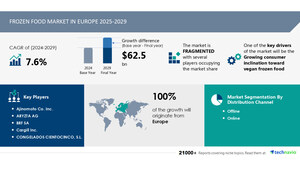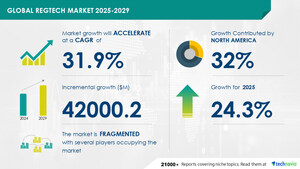NEW YORK, Sept. 24, 2024 /PRNewswire/ -- The global bread maker market size is estimated to grow by USD 309 million from 2024-2028, according to Technavio. The market is estimated to grow at a CAGR of 10.08% during the forecast period. Product innovations and advances leading to portfolio extension and product premiumization is driving market growth, with a trend towards increasing adoption of multi-functional and advanced products. However, threat from counterfeit product poses a challenge. Key market players include AGARO, Bajaj Electricals Ltd., Breville Group Ltd., Cuisinart, DeLonghi Group, Glen Dimplex Europe Holdings Ltd., Hamilton Beach Brands Holding Co., JVCKENWOOD Corp., KENT RO Systems Ltd., Koninklijke Philips N.V., Lifelong Online Retail Pvt. Ltd., NESCO, Newell Brands Inc., Panasonic Holdings Corp., Samsung Electronics Co. Ltd., SANA PRODUCTS LTD., SEB Developpement SA, Sharp Corp., Siroca Inc., Stanley Black and Decker Inc., and Zojirushi Corp..
Key insights into market evolution with AI-powered analysis. Explore trends, segmentation, and growth drivers- View the snapshot of this report
Bread Maker Market Scope |
|
Report Coverage |
Details |
Base year |
2023 |
Historic period |
2018 - 2022 |
Forecast period |
2024-2028 |
Growth momentum & CAGR |
Accelerate at a CAGR of 10.08% |
Market growth 2024-2028 |
USD 309 million |
Market structure |
Fragmented |
YoY growth 2022-2023 (%) |
8.4 |
Regional analysis |
Europe, North America, APAC, South America, and Middle East and Africa |
Performing market contribution |
Europe at 36% |
Key countries |
US, Germany, UK, China, and Canada |
Key companies profiled |
AGARO, Bajaj Electricals Ltd., Breville Group Ltd., Cuisinart, DeLonghi Group, Glen Dimplex Europe Holdings Ltd., Hamilton Beach Brands Holding Co., JVCKENWOOD Corp., KENT RO Systems Ltd., Koninklijke Philips N.V., Lifelong Online Retail Pvt. Ltd., NESCO, Newell Brands Inc., Panasonic Holdings Corp., Samsung Electronics Co. Ltd., SANA PRODUCTS LTD., SEB Developpement SA, Sharp Corp., Siroca Inc., Stanley Black and Decker Inc., and Zojirushi Corp. |
Market Driver
The increasing preference for multi-functional household appliances is driving the market for bread makers. Consumers are willing to invest more in appliances that offer multiple features and functions, as they provide a high return on investment. Multi-functional bread makers save time, resources, and space by eliminating the need for separate appliances for various baking needs. Vendors are continuously innovating to meet this demand and stay competitive. The availability of a wide range of multi-functional bread makers is expected to boost market growth during the forecast period.
The Bread Maker market is experiencing significant growth in the cooking equipment sector, driven by the increasing popularity of home-cooked meals among nuclear families with hectic lives. Economic expansion in emerging countries and discretionary spending power have boosted demand for modern bread machines. Intelligent bread makers with pre-programmed settings and wireless connectivity are trending, making baking easier and more convenient. Brands, local dealers, small shop owners, retailers, and service providers are capitalizing on this trend. Rapid urbanization and the rise of smart kitchen appliances have led to the production of compact bread machines, producing various loaves using raw materials like flour. Working women and small-scale bakeries are major consumers, while food service companies and food processing industries are significant buyers of bread makers and related accessories such as bread pans, paddles, small ovens, timers, and programs. Safety features are a priority, with brands focusing on electrical equipment and technical advances to meet consumer demands.
Request Sample of our comprehensive report now to stay ahead in the AI-driven market evolution!
Market Challenges
- The global bread maker market has faced challenges due to the proliferation of counterfeit products in recent years. These imitations, which mimic the packaging of established brands, are sold at lower prices through unauthorized distributors and online retail channels, particularly in price-sensitive markets like China and India. The easy availability of these counterfeits has led to market fragmentation, resulting in a lack of price standardization, an uneven competitive landscape, and erosion of market shares for international vendors. Moreover, the rise of online shopping has made it easier for counterfeiters to sell their products without product inspections or reviews. Consumers, often unaware of product authentication, may mistakenly purchase counterfeits, blaming genuine brands if the products malfunction. This can significantly harm the reputation of reliable, authentic brands. The digital age enables counterfeiters to deceive consumers with products that resemble branded counterparts, further eroding market trust. Counterfeiting has increased due to consumer preference for lower-priced products and the ease of production and distribution in the digital era. The presence of numerous counterfeit products can hinder the growth of the global bread maker market, potentially leading to decreased revenues for prominent vendors. To mitigate these challenges, it is crucial for market players to focus on product authentication, consumer education, and stricter enforcement of intellectual property rights.
- The bread maker market is experiencing significant growth due to the increasing demand for home-baked products among dual-working families. Fully automatic devices with user-friendly functions have gained popularity, allowing individuals to save time and human efforts. Latest technologies, such as ingredient dispensers for nuts, sultanas, chocolate, and yeast, add convenience. Types of bread, including whole meal loaves and sweet brioche, cater to diverse consumer preferences. High-end models offer connectivity and add-ons like jam, pizza dough, and preservative-free options for the gluten-intolerant population. Simple-to-use and versatile models cater to various sub-segments. The nuclear family trend and working population drive demand for automatic bread makers, with semi-automatic counterparts offering cost-effective alternatives. Commercial places like bakeries, cafes, restaurants, hotels, and grocery stores use commercial bread makers for on-the-go products. Online portals provide easy access to a wide range of bread maker models. The market faces challenges due to competition from commercial bakeries and preservatives in mass-produced bread. However, the trend towards home-baked goods and preservative-free products presents opportunities for growth.
Discover how AI is revolutionizing market trends- Get your access now!
Segment Overview
This bread maker market report extensively covers market segmentation by
- Distribution Channel
- 1.1 Offline
- 1.2 Online
- Product
- 2.1 Automatic bread maker
- 2.2 Regular bread maker
- Geography
- 3.1 Europe
- 3.2 North America
- 3.3 APAC
- 3.4 South America
- 3.5 Middle East and Africa
1.1 Offline- The offline distribution channel for bread makers consists of sales through specialty stores, department stores, hypermarkets, supermarkets, convenience stores, and clubhouse stores. Specialty stores, also known as electronic and specialty retailers (EASRs), are the highest revenue generators in the global bread maker market due to their increasing popularity. Mass merchandisers, including hypermarkets, supermarkets, convenience stores, and clubhouse stores, are the second-largest contributors to the market's revenue. These retailers offer a wide range of products at competitive prices. Department stores are another offline distribution channel that offers bread makers at competitive prices, allowing consumers to evaluate products before purchasing. Factors that influence purchases from department stores include convenience and brand variety. Vendors are managing their sales through local retail entities and maintaining strategic alliances with household appliance retailers to boost offline sales.
Download a Sample of our comprehensive report today to discover how AI-driven innovations are reshaping competitive dynamics
Research Analysis
Bread makers are electrical equipment used to produce fresh bread at home, offering a variety of bread types and designs. They use raw materials like flour, water, yeast, and salt to create loaves, reducing the need for human efforts and time. Small-scale bakeries and family users benefit from this convenient cooking equipment, producing bakery items such as whole meal loaves, sweet brioche, and gluten-free bread without the use of preservatives. Food processing industries also utilize bread-making machines for mass production. A bread maker consists of a bread pan, paddles, oven, timer, and other essential components. With discretionary spending on the rise and economic expansion in emerging countries, the market for bread makers continues to grow, particularly among the working class and nuclear families.
Market Research Overview
Bread makers, an essential electrical equipment for home bakers and small-scale bakeries, offer a variety of bread options beyond the traditional loaf. From whole meal loaves to sweet brioche, these machines use raw materials like flour, yeast, nuts, sultanas, and chocolate to create fresh, preservative-free bread at home. Fully automatic devices with the latest technologies and user-friendly functions have gained popularity among working women and dual-working families. Bread makers come in high-end and simple-to-use models, with some featuring ingredient dispensers for added convenience. The nuclear family trend and hectic lives have led to an increase in demand for on-the-go products, resulting in the development of on-demand and connectivity features. Food processing industries also use bread makers to produce bakery items for commercial places like bakeries, cafes, restaurants, hotels, grocery stores, and online portals. The emergence of rapid urbanization and economic expansion in emerging countries has led to a growing market for these machines among the working population. Bread makers consist of a bread pan, paddles, a small oven, timers, and programs, allowing for customizable baking settings. With the rise of gluten-intolerant populations, preservative-free and gluten-free bread options have become increasingly popular. Brands, local dealers, small shop owners, retailers, and service providers offer a range of bread makers to cater to various consumer preferences and budgets. Whether you're looking for a versatile model that can make jam, pizza dough, or a high-end device with intelligent functions, there's a bread maker out there for you.
Table of Contents:
1 Executive Summary
2 Market Landscape
3 Market Sizing
4 Historic Market Size
5 Five Forces Analysis
6 Market Segmentation
- Distribution Channel
- Offline
- Online
- Product
- Automatic Bread Maker
- Regular Bread Maker
- Geography
- Europe
- North America
- APAC
- South America
- Middle East And Africa
7 Customer Landscape
8 Geographic Landscape
9 Drivers, Challenges, and Trends
10 Company Landscape
11 Company Analysis
12 Appendix
About Technavio
Technavio is a leading global technology research and advisory company. Their research and analysis focuses on emerging market trends and provides actionable insights to help businesses identify market opportunities and develop effective strategies to optimize their market positions.
With over 500 specialized analysts, Technavio's report library consists of more than 17,000 reports and counting, covering 800 technologies, spanning across 50 countries. Their client base consists of enterprises of all sizes, including more than 100 Fortune 500 companies. This growing client base relies on Technavio's comprehensive coverage, extensive research, and actionable market insights to identify opportunities in existing and potential markets and assess their competitive positions within changing market scenarios.
Contacts
Technavio Research
Jesse Maida
Media & Marketing Executive
US: +1 844 364 1100
UK: +44 203 893 3200
Email: [email protected]
Website: www.technavio.com/
SOURCE Technavio

WANT YOUR COMPANY'S NEWS FEATURED ON PRNEWSWIRE.COM?
Newsrooms &
Influencers
Digital Media
Outlets
Journalists
Opted In






Share this article